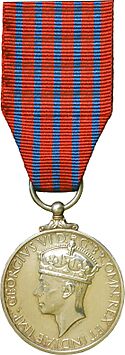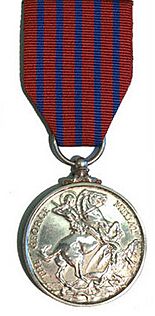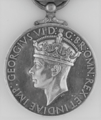George Medal facts for kids
The George Medal (GM) is a special award from the United Kingdom and Commonwealth countries. It was started on September 24, 1940, by King George VI. This medal is given for very brave actions, usually to regular people (civilians), or to military personnel when their bravery isn't directly in battle.
Quick facts for kids George Medal |
|
|---|---|
 
Obverse and reverse of the original medal, showing King George VI
|
|
| Awarded for | Silver disc, 36 mm diameter |
| Presented by | United Kingdom of Great Britain and Northern Ireland and Commonwealth |
Contents
History of the George Medal
In 1940, during World War II, cities in Britain were being heavily bombed. This time was known as the Blitz. Many brave things were done by regular people. The awards that existed then weren't quite right for these new acts of civilian courage. So, the George Cross and the George Medal were created. They were meant to honor brave civilians during bombings and other general acts of courage.
Why the Medal Was Created
When he announced the new awards, King George VI said:
In order that they should be worthily and promptly recognised, I have decided to create, at once, a new mark of honour for men and women in all walks of civilian life. I propose to give my name to this new distinction, which will consist of the George Cross, which will rank next to the Victoria Cross, and the George Medal for wider distribution.
This meant he wanted to quickly recognize the bravery of everyday people. He named these new awards after himself. The George Cross would be a very high honor, almost as important as the Victoria Cross. The George Medal would be given out more widely. The official document for the George Medal was published on January 31, 1941.
What It Takes to Get the Medal
The George Medal is given for "acts of great bravery." At first, the rules for the medal didn't clearly say if it could be given after someone had died. This was made clear in December 1977, allowing awards to be given posthumously (after death). Several such awards have been made since then.
Who Can Receive the Medal?
This medal is mainly for civilians. However, military personnel can also receive it. This happens if their brave actions are not directly in battle against an enemy. The rules state:
The Medal is intended primarily for civilians and award in Our military services is to be confined to actions for which purely military Honours are not normally granted.
This means it's mostly for non-military people. If a military person gets it, it's for bravery outside of typical combat situations.
Special Marks and Bars
People who receive the George Medal can use the letters GM after their name. If someone performs another act of bravery that deserves the medal, they can be awarded a "bar." A bar is a small silver clasp worn on the medal's ribbon. If only the ribbon is worn, a small silver rosette is added to show each bar received.
Details of all awards to British and Commonwealth recipients are published in The London Gazette. Since it started in 1940, about 2,122 George Medals have been awarded. There have also been 27 bars given for second awards.
Design of the George Medal
The George Medal is a round silver medal. It is 36 millimeters (about 1.4 inches) across. The ribbon hangs from a ring at the top.
Front and Back of the Medal
The front of the medal shows the crowned image of the king or queen who was ruling at the time. There have been four different designs for the front:
The back of the medal shows Saint George on horseback. He is slaying a dragon on the coast of England. Around the top edge of the medal, it says "THE GEORGE MEDAL."
The medal was designed by George Kruger Gray. He based it on a bookplate design by Stephen Gooden.
The Ribbon
The ribbon for the George Medal is about 31.7 millimeters (1.25 inches) wide. It is crimson (a deep red color) with five thin blue stripes. The blue color comes from the ribbon of the George Cross. Men wear the medal on their left chest. Women who are not in uniform wear the medal on their left shoulder, with the ribbon tied into a bow. The name of the person who received the medal is usually engraved on its edge.
Notable Recipients
The very first people to receive the George Medal were listed on September 30, 1940. They included Chief Officer Ernest Herbert Harmer and Second Officer Cyril William Arthur Brown of the Dover Fire Brigade. Also, Section Officer Alexander Edmund Campbell of the Dover Auxiliary Fire Service received it. On July 29, 1940, they bravely went back to a ship full of explosives in Dover Harbour to fight fires during an air raid. Seven other people also received the medal, including the first women: Ambulance Driver Dorothy Clarke and Ambulance Attendant Bessie Jane Hepburn. They rescued a badly injured man after an explosion in Aldeburgh, Suffolk.
The first person to receive the medal chronologically was Coxswain Robert Cross. He was the commander of the RNLI lifeboat City of Bradford. His award was announced on February 7, 1941. He received it for an event on February 2, 1940. Cross took the lifeboat out in very strong winds, snow, and rough seas to rescue the crew of a fishing boat.
The youngest person to receive the medal was Charity Anne Bick. She lied about her age to join the ARP service when she was 14. She delivered several messages by bicycle during a heavy air raid in West Bromwich in late 1940. The youngest boy was 14-year-old schoolboy Brian Gibbons. He saved his baby nephew when his house caught fire after a plane crash in Southall in 1959.
The first person to receive a second award (a bar) was George Samuel Sewell. He was an engineer working for Shell-Mex and BP at an oil terminal. He received his bar on July 4, 1941, for his actions during an air raid.
In 2015, a ceremony was held in London to mark the 75th anniversary of the medal's creation.
See also
 In Spanish: Medalla de Jorge para niños
In Spanish: Medalla de Jorge para niños
- Orders and decorations of the Commonwealth realms






